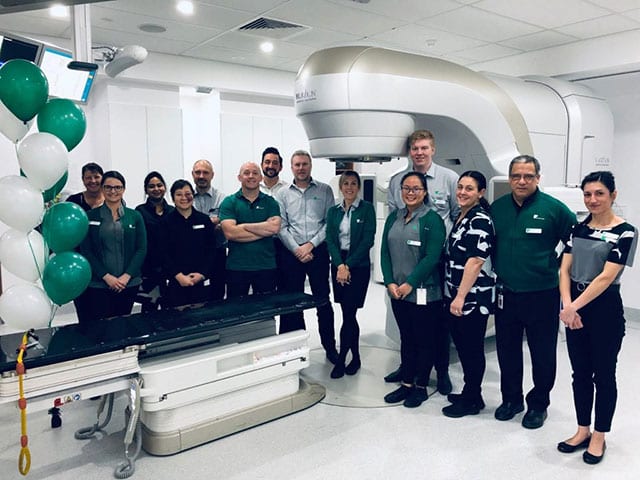- Patients
- What we offer
- Conditions we treat
- Multiple Myeloma
Introduction
Multiple Myeloma treatment and diagnosis
Multiple Myeloma
Multiple myeloma is a cancer of the plasma cells and is an uncommon cancer in the U.S. It’s estimated that around 32,000 people in the US will be diagnosed with multiple myeloma in 2020. We specialize in the latest technologies to treat multiple myeloma that are proven to be effective. Our teams of expert oncologists continually evaluate the latest treatments so we can offer the most up-to-date options to every patient without delay, no matter your multiple myeloma prognosis.

Active surveillance
Chapter 1
Active surveillance
If you are diagnosed with early stage multiple myeloma that is growing very slowly and you are not experiencing any symptoms, your doctor may choose not to treat you immediately. Your doctor will regularly monitor your condition through blood and urine tests for signs that the disease is progressing.
Often multiple myeloma causes no symptoms until it reaches an advanced stage and therefore it is difficult to diagnose it early. The cancer grows so slowly it may take several years before symptoms appear. Symptoms include fatigue, shortness of breath from anemia, fevers and as the cancer progresses, bone pain and broken bones. Multiple myeloma can be found early when a routine blood test shows an abnormally high amount of protein in the blood.
At our centers we offer treatment options that are proven to slow the progress of multiple myeloma, stabilize your condition and help minimize discomfort and pain. Because the tumors are located in bone, surgery is not a treatment option but multiple myeloma can be treated with chemotherapy, targeted therapy, radiation therapy and bone marrow (stem cell) transplant.
Determining the most appropriate treatment for your situation depends on the stage of your multiple myeloma. Your doctor will work with you to decide on the most appropriate treatment plan which will be tailored to you and your needs.
Diagnostic
Chapter 2
Diagnostic
Diagnostic tests for multiple myeloma
Multiple myeloma is often diagnosed with imaging scans, such as MRI, CT and PET, and pathology tests such as blood tests and biopsy, although your doctor may use other tests to identify the problem. You may also have other advanced tests to find out more about your multiple myeloma and which treatments are likely to be most effective. Some of these tests are also used to assess how well your treatment is working.
Find your nearest GenesisCare center to find out what diagnostic tests and scans are available in your local area. Whatever your outcome, our expert team will support you throughout your treatment journey.
Radiation therapy
Chapter 3
Radiation therapy
At GenesisCare we specialize in advanced radiation therapy techniques that are designed to be effective and minimize the side effects you’ll experience.
Our latest-generation machines are built to deliver highly targeted radiation beams. The accuracy of these treatments, together with the expertise of our teams, means that we can often complete a course of radiation therapy in a shorter amount of time - so you can spend more time doing the things you
Radiation therapy for multiple myeloma
Radiation therapy for multiple myeloma may be use to shrink and/or destroy tumors and to alleviate pain in areas of the bone which have not responded to chemotherapy. At GenesisCare our multiple myeloma treatments include external beam radiation therapy (EBRT), where radiation is delivered from outside the body.
Intensity-modulated radiation therapy (IMRT)
IMRT is an advanced external beam radiation therapy technique where the beams of radiation are precisely shaped to exactly match your tumor and damage to adjacent healthy tissues is limited.
Medical oncology
Chapter 4
Medical oncology
At GenesisCare, we offer various drug therapies and a wide range of the latest anti-cancer drugs for the treatment of brain and spinal cord cancers, including chemotherapy and targeted therapy.
Chemotherapy for multiple myeloma
Chemotherapy refers to drugs that destroy cancer cells. Our expert teams may recommend chemotherapy before or after other treatments, or on its own. The type of chemotherapy you’ll receive will also depend on how advanced your multiple myeloma is. Chemotherapy can effectively slow the progress of multiple myeloma.
Targeted therapy for multiple myeloma
As researchers know more about multiple myeloma, they have developed new treatments that can specifically target it. We use targeted therapy to seek and attack cellular activity that the cancer depends on to survive and grow. They are used depending on the specific genetic make up of your cancer. Types of targeted therapy for multiple myeloma include:
- Proteasome inhibitors – block the action of a substance in myeloma cells that breaks down protein. This action causes the cells to die
- HDAC inhibitors – affect which genes are active or turned on inside cells. They do this by interacting with proteins in chromosomes called histones
- Monoclonal antibodies – bind to the specific proteins on myeloma cells, causing them to die
Immunotherapy for multiple myeloma
Immunotherapy helps your body’s own immune system to recognize and fight the cancer. In multiple myeloma, biological therapy drugs such as thalidomide, lenalidomide and pomalidomide are used to enhance the immune system cells which identify and attack cancer cells.
Bone marrow or stem cell transplant for multiple myeloma
A bone marrow transplant, also known as a stem cell transplant, is a procedure which removes the diseased bone marrow and replaces it with healthy, cancer-free bone marrow. It is often used to treat multiple myeloma.
There are two types of bone marrow transplants:
- Autologous transplant – this removes your own stem cells. Blood or marrow is removed and the blood-forming stem cells are separated out. The blood is returned to you and the stem cells are stored until they are needed for the transplant. You will then be treated with high dose chemotherapy to destroy the cells in your bone marrow, including the cancer cells. The stem cells are then returned into your blood through a vein. They travel to your bones and begin rebuilding your bone marrow.
- Allogeneic transplant – this follows the same process as above but it uses stem cells from a donor rather than your own. The donor needs to be closely related to you or have a very similar cell type.
You may need to have two stem cell transplants, 6 to 12 months apart.
Why choose GenesisCare
Chapter 5
Why choose GenesisCare?
GenesisCare U.S. offers community-based cancer care and other services at convenient locations. The company’s purpose is to redefine the care experience by improving patient outcomes, access and care delivery. With advanced technology and innovative treatment options, skilled physicians and support staff offer comprehensive and coordinated care in radiation oncology, medical oncology, hematology, urology, diagnostics, ENT, and surgical oncology.
Read next

Who we are
Across the world, we have more than 140 centers across Florida and North Carolina, offering the latest treatments and technologies that have been proven to help patients achieve the best possible outcomes.

Our locations
With centers throughout Florida and North Carolina, you can get fast access to world-class, personalized healthcare close to home.

Working with us
Join a company with the mission to personalize global cancer care and improve patient outcomes.

News room - What's been happening
From new centers and technologies to the latest innovations in care, stay on top of what we are doing
